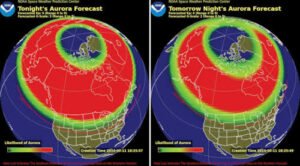**Future Opportunities to Witness the Northern Lights Across the U.S.: Where to Look This Week**
This week brings exciting opportunities for skywatchers across the United States as conditions are aligning for the potential appearance of the Northern Lights, also known as the aurora borealis. This beautiful natural phenomenon, typically viewed closer to the poles, may become visible further south than usual due to increased solar activity. Below, we outline where and when to look for this vibrant display of lights, including a map detailing potential viewing zones across the U.S.
### What Are the Northern Lights?
The Northern Lights occur when solar particles collide with Earth’s atmosphere, creating dazzling lights that vary in color from greens and purples to reds and blues. These colors depend on which gases in the atmosphere the solar particles interact with; oxygen produces green and red hues, while nitrogen causes blue and purples. Increased solar activity, such as solar flares and coronal mass ejections (CMEs), can intensify the aurora borealis and extend its reach to lower latitudes.
### This Week’s Viewing Opportunities: Where to Look
Due to a recent strong solar flare, a geomagnetic storm is expected this week, which could create visibility opportunities for the Northern Lights across much of the northern United States. Below are key regions to watch and some tips on maximizing your viewing experience.
1. **Upper Midwest and Great Lakes Region**
– **States**: Minnesota, Wisconsin, Michigan, and North Dakota
– **Best Time**: Late evening to early morning (after 10 p.m. local time)
– **Details**: Clear skies in this region could provide excellent visibility, particularly in rural areas away from city lights.
2. **Pacific Northwest**
– **States**: Washington, Oregon, and northern Idaho
– **Best Time**: Around midnight to the early hours
– **Details**: Areas along the northern parts of these states are likely to see faint auroras if conditions are clear. Try heading to higher altitudes if possible.
3. **Northeast and New England**
– **States**: Maine, New Hampshire, Vermont, and northern New York
– **Best Time**: Midnight to pre-dawn hours
– **Details**: Areas with minimal light pollution offer the best chances for visibility, especially in northern Maine, which may experience some of the brightest displays.
4. **Northern Plains and Rocky Mountains**
– **States**: Montana, Wyoming, and northern Colorado
– **Best Time**: After midnight
– **Details**: If you’re in a rural area or have access to high ground, the chances of viewing the aurora in Montana are especially high. Some areas in Wyoming and northern Colorado may also get a glimpse of the lights.

### Viewing Tips and Recommendations
– **Check Weather and Sky Conditions**: Cloud cover is the biggest obstacle, so use a weather app to monitor local conditions and pick a clear night if possible.
– **Get Away from City Lights**: Light pollution from cities can reduce visibility, so find a dark area like a national park or rural field.
– **Use an Aurora Forecast Tool**: Websites and apps like NOAA’s Space Weather Prediction Center or the Aurora Forecast App provide real-time updates on geomagnetic activity and aurora strength.
– **Plan for Patience**: The auroras may not be visible right away, so give yourself a few hours to catch a good display.
### This Week’s Aurora Map
This week’s aurora map highlights areas where aurora activity is expected to be strongest. The map shows an extended viewing range due to the powerful geomagnetic storm, which could stretch from the northern U.S. border down to the central parts of some states. Locations further south may see faint glows, while those within the higher-latitude states have the best chance for a full spectrum of colors.
### Looking Ahead: Future Opportunities
Solar activity follows an 11-year cycle, with peaks bringing increased aurora visibility. The current solar cycle, expected to reach its peak in the coming years, suggests that more frequent auroras may continue to be visible in the northern United States. Keep an eye on solar activity forecasts for future aurora possibilities!
For those hoping to experience the aurora borealis, this week provides a rare opportunity to witness this natural light show without traveling to the Arctic Circle.



